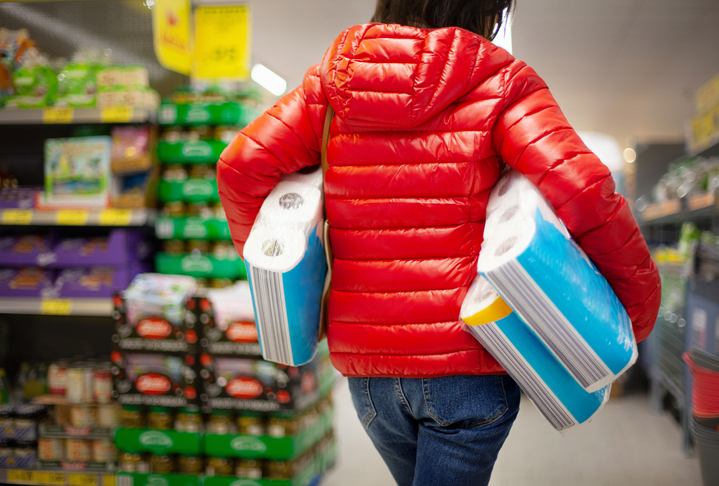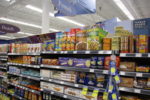
Before You Go
Plan your trips carefully
Despite the CDC’s recommendations, grocery workers across the country have been reporting some customers are still making routine daily trips to the grocery store. While under normal circumstances workers are happy to see familiar faces every day, it is not safe right now because of coronavirus.
Make fewer trips to the store by practicing meal planning and balancing fresh produce and other perishable items with frozen, dried, or canned goods. Bring a list with you.
If you still find yourself making frequent trips for small items, try to coordinate with friends or neighbors and take turns making shopping trips. Just be sure to use good social distancing practices when exchanging groceries.
Check store policies
Look online for what your store is doing to protect both customers and workers. Many stores now close early to sanitize or offer dedicated shopping hours to senior customers and other at-risk groups. Some stores have installed sneeze-guards at the checkouts and put colored tape on floors to help customers keep their distance while in the checkout lane. If you find your store hasn’t taken any precautions, call and ask to speak with the manager and let them know safety is a priority for you and they need to do better.
Wash your hands
Yes, you need to wash your hands when you get back to the store, but washing your hands before you leave also can cut down on you inadvertently spreading germs to others.
Go solo
We know your family is going stir-crazy, but a trip to the grocery store right now should be treated as a serious occasion and a necessity, not a social outing. If you are able to, have one person in the family go shopping and while others stay at home.
At the store
Bring your own hand sanitizer and wipes, if you have them
While the UFCW has been working with many union grocery employers to make sure they provide hand sanitizer and wipes, recognize that this is a challenging time for everyone. It’s best to bring your own if you can just in case they are out. Use the wipes to wipe down the shopping cart.
But don’t panic if you don’t have any wipes. “The risk of becoming infected from touching any individual shopping cart is probably very, very low,” said Dr. Daniel Winetsky, infectious diseases fellow at Columbia University Irving Medical Center, in a recent article in The New York Times. “So if wipes are not available, there is no need to abandon your grocery shopping needs. Just try not to touch your face while shopping, and wash your hands or use hand sanitizer after you are done.”
If you use gloves, use them properly
Gloves, when used properly, can help you keep your hands clean, but it is important to remember that if you touch your face while wearing gloves or touch anything else you are shopping for, an unwashed glove and an unwashed hand both carry the same risk of cross contamination. So remember, don’t let the fact you are wearing gloves lure you into a false sense of security. You should still avoid touching whatever surfaces you can while you are shopping.
Put used gloves into the trash can
Used gloves should be discarded of immediately directly into the trash can, not thrown on the ground of the parking lot or shoved into a pocket. Making someone else clean up after you and exposing them to all the germs you could have picked up while shopping is not in the spirit of the #ShopSmart pledge, and isn’t being very thoughtful to the essential workers who already have enough to deal with.
Follow rules and posted guidelines
Remember to not only keep 6 feet away from other customers, but from workers, as well. If a grocery worker is stocking a shelf and you need an item near them, either let them continue doing their job and check back at the end of your trip, or politely let them know you would like to get an item near them.
Avoid cash transactions if you can
This includes not only paying for groceries, but purchasing lottery tickets or getting cash back from the register. Cash passes through a number of hands, both before and after it touches your wallet. It’s also safer for workers to avoid using cash if you can right now.
When You Get Home
Wash your hands and face
You probably know to wash your hands already, but it is a good idea to wash your face, as well. Sometimes, it is difficult to know whether you’ve touched your face or not while you were out because it’s often such a subconscious act. If you have sensitive skin, your normal facial soap is likely fine to use. Since we’re dealing with a virus, you don’t need soap that specifically says it’s “antibacterial” for it to work, it just needs to be able to get you clean.
Take your shoes off or disinfect them
Disinfecting the soles of your shoes can help keep from tracking any germs, not just COVID-19, around your house. This is especially important if you have kids who might spend more time rolling around on the floor than you do.
Disinfect what groceries you can
While there is no evidence the coronavirus is transmitted through food, there’s no harm in wiping down non-porous items such as bottles of juice or removing cereal from the outer box it comes in just in case. Wash produce with soap and water. Put all of the discarded packaging and soiled paper towels into a bag, then seal it up and throw it away.
When you are done, wipe down the surface the groceries were on. Put any bags into a clean back and seal them up. If you plan to reuse the bags around the house as trash bags like lots of thrifty households do, keep them sealed up and stored somewhere out of the way for at least a few days first.
Change your clothes and take a shower
Change your clothes when you get home from the grocery store and put them in the wash. Shopping right now is stressful. In addition to being cleaner and reducing the chance of any cross-contamination, you’ll also just feel better if you take a shower when you get home.



